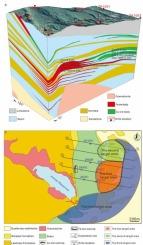Application of infrared (IR) spectral for exploration indicators in the Zhouwu Fe-Cu Skarn Deposit, South China
IF 3.6
2区 地球科学
Q1 GEOLOGY
引用次数: 0
Abstract
The Nanling Range is a globally significant W-Sn polymetallic province in South China, which is mainly associated with the Mesozoic magmatism. The recently discovered Zhouwu deposit, situated along the southern margin of this range, is classified as a stratabound skarn-type Fe-Cu system, with an inferred ore reserves of 24 million tons of Fe and 42 thousand tons of Cu. This system exhibits distinct lithological control, with mineralization and alteration predominantly concentrated in ore-rich strata within the Zhouwu deposit, with poor development of mineralogical zonation. This study systematically elucidates the alteration mineral assemblages and their spatiotemporal relationships with mineralization through detailed geological surveys, mineralogical observations, and an integration of thermal infrared (TIR) spectroscopy, short-wave infrared (SWIR) spectroscopy, and electron probe micro-analysis of pyroxene. This study reveals that the paragenesis of the Zhouwu deposit can be subdivided into distinct phases, i.e., garnet-pyroxene, iron oxide, sulfide, and carbonate stages. The spectral parameters for garnet (Pos 11,400 > 11,400 nm), chlorite (Pos 2335 < 2335 nm), and white mica (Dep 1900 < 0.36) are closely associated with Fe and Cu mineralization. Additionally, the presence of diopside combined with low Pos 9700 values (Pos 9700 < 9720 nm) can serve as a proximal indicator for iron-rich fluids, suggesting magnesium enrichment in pyroxene within the proximal zone of iron mineralization. In addition, the spectral characteristics of chlorite and white mica exhibit subtle differences between Fe and Cu deposits. These findings suggest that Fe mineralization formed under high temperature, oxidizing conditions, while Cu mineralization takes place under medium–high temperature, less oxidizing conditions. Integrating spectral parameters with ore-forming fluid evolution, three exploration target zones were identified. Overall, this research underscores the effectiveness of combining TIR and SWIR spectroscopy in skarn exploration, particularly in stratabound skarn-type Fe-Cu system such as Zhouwu.

红外光谱在周武铁铜矽卡岩矿床勘探指示中的应用
南岭山脉是中国南方一个全球重要的钨锡多金属省,主要与中生代岩浆活动有关。最近发现的周武矿床位于该构造带南缘,属层控矽卡岩型铁铜体系,推断储量为铁2400万吨,铜4.2万吨。该系统具有明显的岩性控制作用,成矿和蚀变作用主要集中在周武矿床内的富矿地层中,矿物学分带发育较差。通过详细的地质调查、矿物学观测,结合热红外光谱(TIR)、短波红外光谱(SWIR)和电子探针显微分析,系统阐明了辉石蚀变矿物组合及其与成矿作用的时空关系。研究表明,周武矿床共生可划分为石榴石—辉石、氧化铁、硫化物和碳酸盐阶段。石榴石(po11,400 > 11,400 nm)、绿泥石(po2335 < 2335 nm)和白云母(Dep 1900 < 0.36)的光谱参数与Fe和Cu矿化密切相关。此外,透辉石的存在与较低的po9700值(po9700 < 9720 nm)可以作为富铁流体的近端指示,表明在近端铁矿化带辉石中镁富集。此外,绿泥石和白云母的光谱特征在Fe和Cu矿床中表现出细微的差异。这些结果表明,铁矿化是在高温氧化条件下形成的,而铜矿化是在中高温低氧化条件下形成的。将光谱参数与成矿流体演化相结合,确定了3个勘探目标区。综上所述,本研究强调了TIR和SWIR光谱相结合在矽卡岩勘探中的有效性,特别是在周武等层控矽卡岩型铁铜体系中。
本文章由计算机程序翻译,如有差异,请以英文原文为准。
求助全文
约1分钟内获得全文
求助全文
来源期刊

Ore Geology Reviews
地学-地质学
CiteScore
6.50
自引率
27.30%
发文量
546
审稿时长
22.9 weeks
期刊介绍:
Ore Geology Reviews aims to familiarize all earth scientists with recent advances in a number of interconnected disciplines related to the study of, and search for, ore deposits. The reviews range from brief to longer contributions, but the journal preferentially publishes manuscripts that fill the niche between the commonly shorter journal articles and the comprehensive book coverages, and thus has a special appeal to many authors and readers.
 求助内容:
求助内容: 应助结果提醒方式:
应助结果提醒方式:


